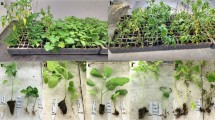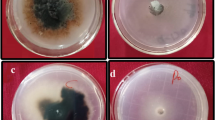Abstract
Fusarium corm rot of saffron (Crocus sativus L.), incited by Fusarium oxysporum f. sp. gladioli, causes severe yield losses in Italy. Major symptoms during flowering (October–November) include yellowing and wilting of shoots, basal stem rot and corm rot. Sixty-four isolates of F. oxysporum f. sp. gladioli, obtained from infected saffron crops located in Italy (Abruzzi, Tuscany and Umbria) and in Spain, were characterized by pathogenicity and vegetative compatibility. Chlorate-resistant, nitrate-nonutilizing (nit) mutants were used to determine vegetative compatibility among the isolates of the pathogen with the aim of examining the genetic relatedness among populations from different locations. All the isolates belonged to vegetative compatibility group 0340. Since saffron shares susceptibility to F. oxysporum f. sp. gladioli with other ornamental plants of the Iridaceae (Crocus, Gladiolus, Iris and Ixia), it is likely that a clone of the pathogen (VCG 0340) was introduced with other hosts and is responsible for the disease outbreak observed on saffron in Italy. Alternatively, or additionally, the clone of F. oxysporum f. sp. gladioli causing disease on saffron in other countries may have spread to the saffron fields in Italy through the import and dispersal of infested propagation material.
Similar content being viewed by others
References
Baayen RP, O'Donnell K, Bonants PJM, Cigelnik E, Kroon LPNM, Roebroeck EJA and Waalwijk C (2000) Gene genealogies and AFLP analyses in the Fusarium oxysporum complex identify monophyletic and nonmonophyletic formae speciales causing wilt and rot disease. Phytopathology 90: 891–900
Brayford D (1996) Fusarium oxysporum f. sp. gladioli. Mycopathologia 133: 47–48
Cappelli C (1994) Occurrence of Fusarium oxysporum f. sp. gladioli on saffron in Italy. Phytopathologia Mediterranea 33: 93–94
Cappelli C and Di Minco G (1998) Control of Fusarium oxysporum f. sp. gladioli based on the production of pathogen free saffron corms. Journal of Plant Pathology 80: 253
Cappelli C and Di Minco G (1999) Results of a triennial study on saffron diseases in Abruzzi. Informatore Fitopatologico 49: 27–32 (in Italian)
Correll JC, Klittich CJR and Leslie JF (1987) Nitrate non-utilizing mutants of Fusarium oxysporum and their use in vegetative compatibility tests. Phytopathology 77: 1640–1646
de Haan AM, Numansen A, Roebroeck EJA and van Doorn J (2000) PCR detection of Fusarium oxysporum f. sp.gladioli race 1, causal agent of Gladiolus yellows disease, from infected corms. Plant Pathology 49: 89–100
Di Primo P and Cappelli C (2000) Preliminary study on vegetative compatibility groups of Fusarium oxysporum f. sp. gladioli isolates obtained from saffron in Italy. Informatore Fitopatologico 50: 35–38(in Italian)
Di Primo P, Cartia G and Katan T (2001) Vegetative compatibility and heterokaryon stability in Fusarium oxysporum f. sp. radicis-lycopersici in Italy. Plant Pathology 50: 371–382
Garcia-Jimenez J and Alfaro Garcia A (1987) Fusarium oxysporum Schlecht. as causal agent of a seedborne disease of saffron (Crocus sativus L.). In: Proceedings of the 7th Congress of the Mediterranean Phytopathological Union (p 156) Granada, Spain
Gordon TR and Martyn RD (1997) The evolutionary origin of Fusarium oxysporum. Annual Review of Phytopathology 35: 111–128
Gullino ML, Armato B and Romano ML (1983) Introduction in Italy of Iris bulbs infested by Fusarium oxysporum f. sp. gladioli and Penicillium corymbiferum resistant to benzimidazoles. Informatore Fitopatologico 33: 110–111 (in Italian)
Katan T and Di Primo P (1999) Current status of vegetative compatibility in Fusarium oxysporum: Supplement (1999) Phytoparasitica 27: 273–277
Mes JJ, van Dorn J, Roebroeck EJA, van Egmond E, van Aartrijk J and Boonekamp PM (1994) Restriction fragment length polymorphisms, races and vegetative compatibility groups within a worldwide collection of Fusarium oxysporum f. sp. gladioli. Plant Pathology 43: 362–370
Roebroeck EJA (2000) Fusarium oxysporum from iridaceous crops: Analysis of genetic diversity and host specialisation. Ph.D. thesis, University of Amsterdam, The Netherlands ISBN 90–9013802–1 (p 124)
Roebroeck EJA and Mes JJ (1992) Physiological races and vegetative compatibility groups within Fusarium oxysporum f. sp. gladioli. Netherland Journal of Plant Pathology 98: 57–64
Shah A and Srivastava KK (1984) Control of corm rot of saffron. Progressive Horticulture 16: 141–143
Simon JE, Chadwick AF and Craker LE (1984) Herbs: An Indexed Bibliography. 1971–1980. The Scientific Literature on Selected Herbs, and Aromatic and Medicinal Plants of the Temperate Zone. Archon Books, Hamden, CT, USA
Sperati G (1998) Botany of the Dominican monks. Rare plants of Italy. Saffron crocus of the Navelli plain (Abruzzo). Bollettino dell'Associazione Micologica ed Ecologica Romana 44: 22–31 (in Italian)
Yamamoto W, Omatsu T and Takami K (1954) Studies on the corm rots of Crocus sativus L. I. On saprophytic propagation of Sclerotinia gladioli and Fusarium oxysporum f. sp. gladioli on various plants and soils. Scientific Reports Hyogo University of Agriculture 1: 64–70 (Review of Applied Mycology 35: 327)
Author information
Authors and Affiliations
Rights and permissions
About this article
Cite this article
Di Primo, P., Cappelli, C. & Katan, T. Vegetative Compatibility Grouping of Fusarium oxysporum f. sp. gladioli from Saffron. European Journal of Plant Pathology 108, 869–875 (2002). https://doi.org/10.1023/A:1021204022787
Issue Date:
DOI: https://doi.org/10.1023/A:1021204022787




